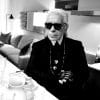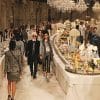Karl Lagerfeld was more than a fashion designer, or creative director of the illustrious maisons he worked for—Chanel for 36 years; Fendi for 52! He was an artist, photographer, intellectual, epicurean, historian, and a modern-day philosopher. Gosh, some of the quips he came up with:
“Chic is a kind of mayonnaise, either it tastes, or it doesn’t.”
“Vanity is the healthiest thing in life.”
And my all-time favourite, “Life is not a fashion show.”
“This is not a colonialist collection,” he threw at me rather acerbically when I interviewed him backstage after the Chanel Paris-Bombay Metiers d’Art 2012 show, where he transformed Galerie Courbe at the Grand Palais in Paris into a maharaja’s palace. The front row was an extravagant banquet of sweets and delicacies as guests imbibed on tea and gin while watching the intricate India-inspired collection presented within the circular centre. There was a toy train running table-to-table, carrying bottles of scotch in its carriage—“Colonialist is a rather strange idea, he said, “Let’s say it’s a mix of India with England.” His historical references were sharp and witty; you had to know them to fully appreciate his genius mind.

Natasha Kraal with Karl Lagerfeld backstage
Lagerfeld was all about his mega show—and I have been to countless runway experiences. He’s staged everything from an art gallery to a supermarket to a chic Paris bistro as the scenography for his collections at Chanel, each capturing the cultural zeitgeist. He always held his Spring/Summer and Autumn/Winter collections at the Grand Palais in Paris, where he’s also erected massive edifices for his shows, from a replica of the Eiffel Tower to the enormous Chanel tweed jacket that models walked out from. Then there were the epic location shows, my most memorable being the Chanel Cruise 2016/17 collection in Cuba, where all 800 guests arrived in vintage cars for the show on the Paseo del Prado, which ended up being one big salsa extravaganza (the Chanel after-show parties are equally spectacular). The last of Lagerfeld’s shows I attended was the Paris-New York Métiers d’Art collection in December 2018, at the Temple of Dendur in The Met … the rich layers of ancient Egyptian history clashing with the 1980s graffiti art and styles of NYC really showed his intellectual depth and creative brilliance.

Natasha Kraal with Karl Lagerfeld, on deck chairs along the embankment of the Seine by the gilded Pont Alexandre III and the Eiffel Tower on the other side of the river
His work for Fendi takes this to a different realm. Last year’s couture collection was truly his best, where he played with versions of plastic to challenge our notions on luxury, and as his commentary on sustainability in fashion. My third and final interview with Lagerfeld was at his photographic exhibition ‘The Glory of Water’, of the iconic fountains of Rome, where the USD2.8 million restoration of the Trevi Fountain was sponsored by Fendi. I opened the interview with a line from Lagerfeld’s prologue in his book—“Beauty not perceived is a pleasure not felt”, a quote by the Spanish-American philosopher George Santayana, from his book The Sense Of Beauty, one of Lagerfeld’s favourite—and we talked about philosophy and photography. It was more than about fashion, and yet everything that is about fashion. And so, there we were sitting down by the calm waters of the Seine in Paris, with the Eiffel Tower in the horizon, and his signature Diet Coke in his hand. As we closed the interview, he stood up and told me, again, “I like the idea that you know Santayana, really.” Read this book; it defines the mind and soul of Karl Lagerfeld, the philosopher, aesthete, and one of the greatest designers of our times.



